Teaching English as an Additional Language
VerifiedAdded on 2023/03/17
|12
|3825
|47
AI Summary
This article discusses the challenges faced by students learning English as an additional language and provides strategies and resources to support their learning. It explores the importance of phonics, pronunciation, and fluency in language acquisition and suggests activities to close the learning gap. The article also highlights the role of formative assessment in monitoring student progress.
Contribute Materials
Your contribution can guide someone’s learning journey. Share your
documents today.
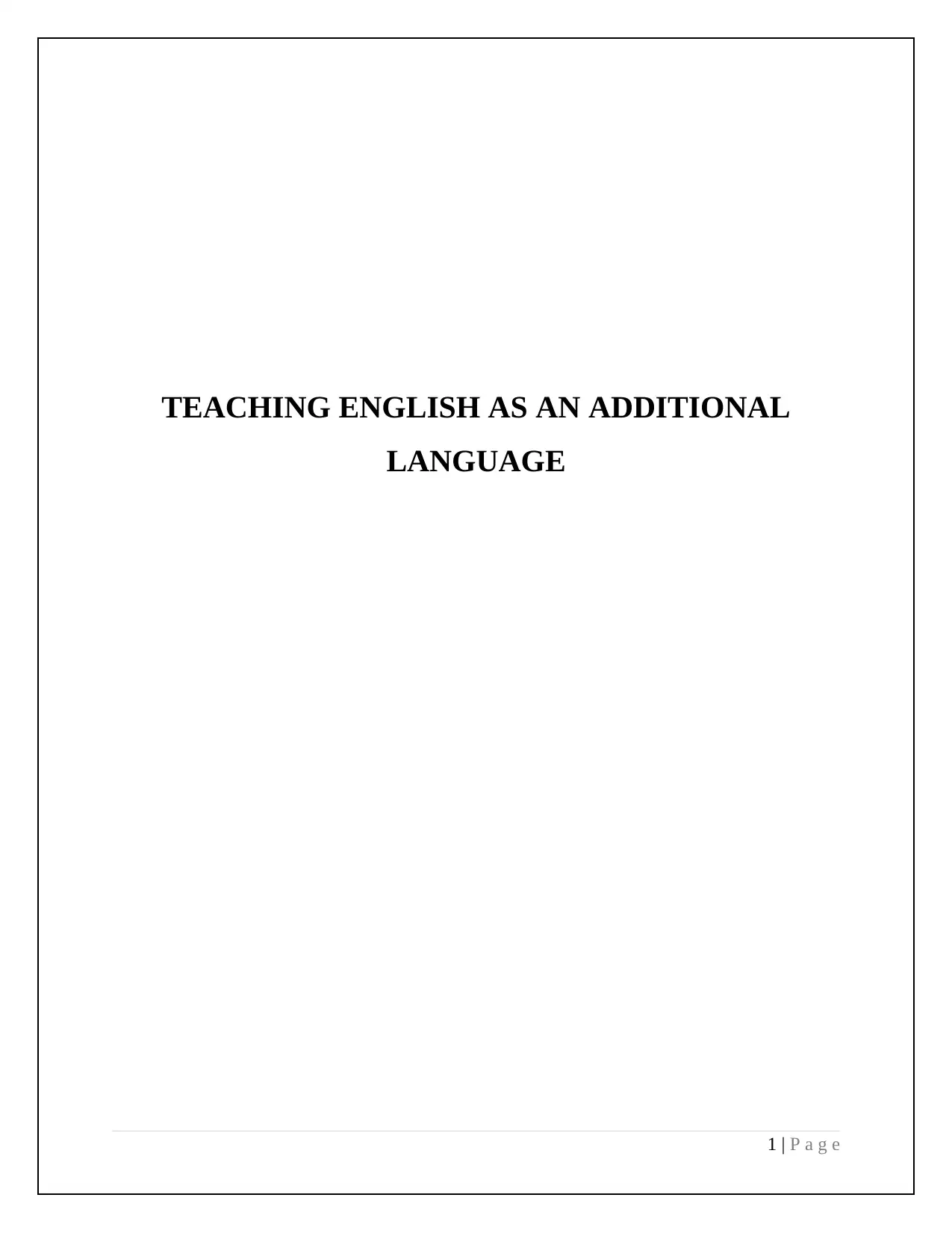
TEACHING ENGLISH AS AN ADDITIONAL
LANGUAGE
1 | P a g e
LANGUAGE
1 | P a g e
Secure Best Marks with AI Grader
Need help grading? Try our AI Grader for instant feedback on your assignments.
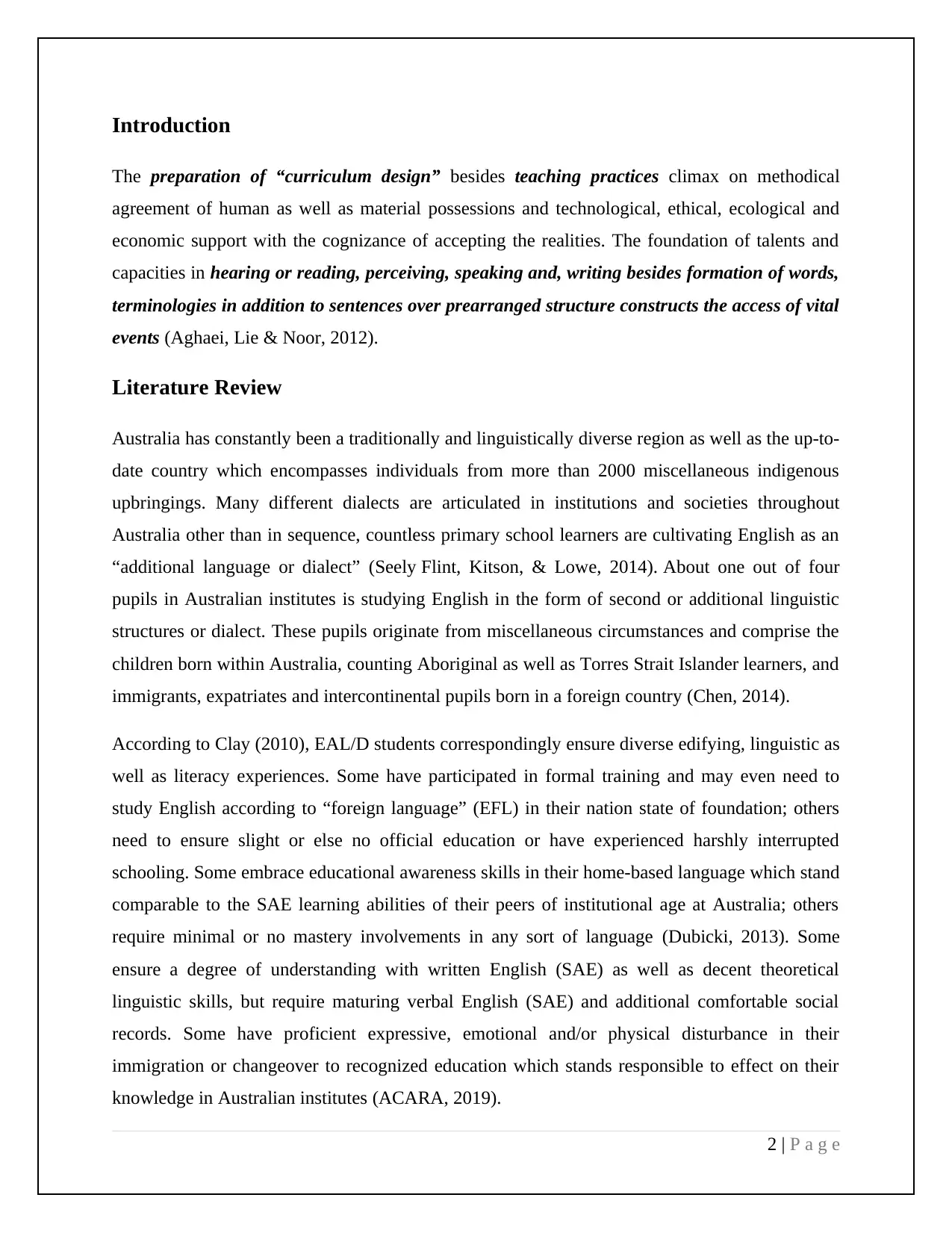
Introduction
The preparation of “curriculum design” besides teaching practices climax on methodical
agreement of human as well as material possessions and technological, ethical, ecological and
economic support with the cognizance of accepting the realities. The foundation of talents and
capacities in hearing or reading, perceiving, speaking and, writing besides formation of words,
terminologies in addition to sentences over prearranged structure constructs the access of vital
events (Aghaei, Lie & Noor, 2012).
Literature Review
Australia has constantly been a traditionally and linguistically diverse region as well as the up-to-
date country which encompasses individuals from more than 2000 miscellaneous indigenous
upbringings. Many different dialects are articulated in institutions and societies throughout
Australia other than in sequence, countless primary school learners are cultivating English as an
“additional language or dialect” (Seely Flint, Kitson, & Lowe, 2014). About one out of four
pupils in Australian institutes is studying English in the form of second or additional linguistic
structures or dialect. These pupils originate from miscellaneous circumstances and comprise the
children born within Australia, counting Aboriginal as well as Torres Strait Islander learners, and
immigrants, expatriates and intercontinental pupils born in a foreign country (Chen, 2014).
According to Clay (2010), EAL/D students correspondingly ensure diverse edifying, linguistic as
well as literacy experiences. Some have participated in formal training and may even need to
study English according to “foreign language” (EFL) in their nation state of foundation; others
need to ensure slight or else no official education or have experienced harshly interrupted
schooling. Some embrace educational awareness skills in their home-based language which stand
comparable to the SAE learning abilities of their peers of institutional age at Australia; others
require minimal or no mastery involvements in any sort of language (Dubicki, 2013). Some
ensure a degree of understanding with written English (SAE) as well as decent theoretical
linguistic skills, but require maturing verbal English (SAE) and additional comfortable social
records. Some have proficient expressive, emotional and/or physical disturbance in their
immigration or changeover to recognized education which stands responsible to effect on their
knowledge in Australian institutes (ACARA, 2019).
2 | P a g e
The preparation of “curriculum design” besides teaching practices climax on methodical
agreement of human as well as material possessions and technological, ethical, ecological and
economic support with the cognizance of accepting the realities. The foundation of talents and
capacities in hearing or reading, perceiving, speaking and, writing besides formation of words,
terminologies in addition to sentences over prearranged structure constructs the access of vital
events (Aghaei, Lie & Noor, 2012).
Literature Review
Australia has constantly been a traditionally and linguistically diverse region as well as the up-to-
date country which encompasses individuals from more than 2000 miscellaneous indigenous
upbringings. Many different dialects are articulated in institutions and societies throughout
Australia other than in sequence, countless primary school learners are cultivating English as an
“additional language or dialect” (Seely Flint, Kitson, & Lowe, 2014). About one out of four
pupils in Australian institutes is studying English in the form of second or additional linguistic
structures or dialect. These pupils originate from miscellaneous circumstances and comprise the
children born within Australia, counting Aboriginal as well as Torres Strait Islander learners, and
immigrants, expatriates and intercontinental pupils born in a foreign country (Chen, 2014).
According to Clay (2010), EAL/D students correspondingly ensure diverse edifying, linguistic as
well as literacy experiences. Some have participated in formal training and may even need to
study English according to “foreign language” (EFL) in their nation state of foundation; others
need to ensure slight or else no official education or have experienced harshly interrupted
schooling. Some embrace educational awareness skills in their home-based language which stand
comparable to the SAE learning abilities of their peers of institutional age at Australia; others
require minimal or no mastery involvements in any sort of language (Dubicki, 2013). Some
ensure a degree of understanding with written English (SAE) as well as decent theoretical
linguistic skills, but require maturing verbal English (SAE) and additional comfortable social
records. Some have proficient expressive, emotional and/or physical disturbance in their
immigration or changeover to recognized education which stands responsible to effect on their
knowledge in Australian institutes (ACARA, 2019).
2 | P a g e

The EAL/D Learning evolution embraces extensive demonstrations of the individualities of
learner clusters at all the four stages of English philological learning. Learners of any age may be
in any of the language learning phases.
(Source: ACARA, 2019)
There are legitimately stimulating and consistent events of nurturing the children based on the
systematic groundwork of training. The instruction of language intrudes the developing plans of
instructing the essence of literacy in the mental setting of the persons who pursue to study the
wide-ranging features of lessons instructed to them (Lacewing, 2014).
McCabe (2012) opined that the proper presentation of productive designs of the usage of
synthetic along with analytic structures of phonics affords systematic interpretation. This
indicates the awareness of mechanism of spellings plus graphical advantage of the depictions of
living or else inorganic matters to validate the theoretical outline of distinguishing the letters
besides integration of vowels plus consonants to formulate the words in keeping with the sounds
as well as meanings. The manmade or non-natural preparation proves the amalgamation of letters
3 | P a g e
learner clusters at all the four stages of English philological learning. Learners of any age may be
in any of the language learning phases.
(Source: ACARA, 2019)
There are legitimately stimulating and consistent events of nurturing the children based on the
systematic groundwork of training. The instruction of language intrudes the developing plans of
instructing the essence of literacy in the mental setting of the persons who pursue to study the
wide-ranging features of lessons instructed to them (Lacewing, 2014).
McCabe (2012) opined that the proper presentation of productive designs of the usage of
synthetic along with analytic structures of phonics affords systematic interpretation. This
indicates the awareness of mechanism of spellings plus graphical advantage of the depictions of
living or else inorganic matters to validate the theoretical outline of distinguishing the letters
besides integration of vowels plus consonants to formulate the words in keeping with the sounds
as well as meanings. The manmade or non-natural preparation proves the amalgamation of letters
3 | P a g e
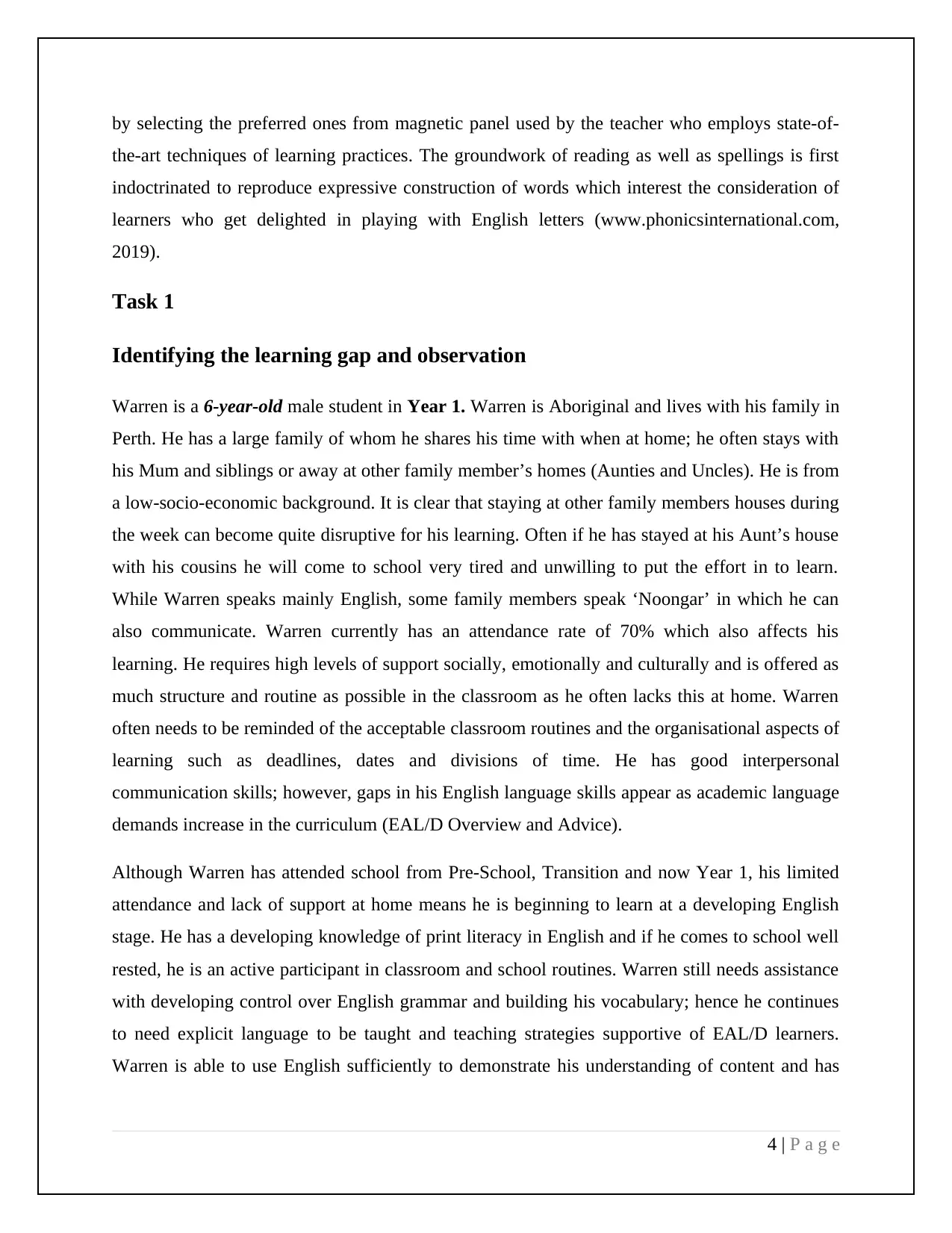
by selecting the preferred ones from magnetic panel used by the teacher who employs state-of-
the-art techniques of learning practices. The groundwork of reading as well as spellings is first
indoctrinated to reproduce expressive construction of words which interest the consideration of
learners who get delighted in playing with English letters (www.phonicsinternational.com,
2019).
Task 1
Identifying the learning gap and observation
Warren is a 6-year-old male student in Year 1. Warren is Aboriginal and lives with his family in
Perth. He has a large family of whom he shares his time with when at home; he often stays with
his Mum and siblings or away at other family member’s homes (Aunties and Uncles). He is from
a low-socio-economic background. It is clear that staying at other family members houses during
the week can become quite disruptive for his learning. Often if he has stayed at his Aunt’s house
with his cousins he will come to school very tired and unwilling to put the effort in to learn.
While Warren speaks mainly English, some family members speak ‘Noongar’ in which he can
also communicate. Warren currently has an attendance rate of 70% which also affects his
learning. He requires high levels of support socially, emotionally and culturally and is offered as
much structure and routine as possible in the classroom as he often lacks this at home. Warren
often needs to be reminded of the acceptable classroom routines and the organisational aspects of
learning such as deadlines, dates and divisions of time. He has good interpersonal
communication skills; however, gaps in his English language skills appear as academic language
demands increase in the curriculum (EAL/D Overview and Advice).
Although Warren has attended school from Pre-School, Transition and now Year 1, his limited
attendance and lack of support at home means he is beginning to learn at a developing English
stage. He has a developing knowledge of print literacy in English and if he comes to school well
rested, he is an active participant in classroom and school routines. Warren still needs assistance
with developing control over English grammar and building his vocabulary; hence he continues
to need explicit language to be taught and teaching strategies supportive of EAL/D learners.
Warren is able to use English sufficiently to demonstrate his understanding of content and has
4 | P a g e
the-art techniques of learning practices. The groundwork of reading as well as spellings is first
indoctrinated to reproduce expressive construction of words which interest the consideration of
learners who get delighted in playing with English letters (www.phonicsinternational.com,
2019).
Task 1
Identifying the learning gap and observation
Warren is a 6-year-old male student in Year 1. Warren is Aboriginal and lives with his family in
Perth. He has a large family of whom he shares his time with when at home; he often stays with
his Mum and siblings or away at other family member’s homes (Aunties and Uncles). He is from
a low-socio-economic background. It is clear that staying at other family members houses during
the week can become quite disruptive for his learning. Often if he has stayed at his Aunt’s house
with his cousins he will come to school very tired and unwilling to put the effort in to learn.
While Warren speaks mainly English, some family members speak ‘Noongar’ in which he can
also communicate. Warren currently has an attendance rate of 70% which also affects his
learning. He requires high levels of support socially, emotionally and culturally and is offered as
much structure and routine as possible in the classroom as he often lacks this at home. Warren
often needs to be reminded of the acceptable classroom routines and the organisational aspects of
learning such as deadlines, dates and divisions of time. He has good interpersonal
communication skills; however, gaps in his English language skills appear as academic language
demands increase in the curriculum (EAL/D Overview and Advice).
Although Warren has attended school from Pre-School, Transition and now Year 1, his limited
attendance and lack of support at home means he is beginning to learn at a developing English
stage. He has a developing knowledge of print literacy in English and if he comes to school well
rested, he is an active participant in classroom and school routines. Warren still needs assistance
with developing control over English grammar and building his vocabulary; hence he continues
to need explicit language to be taught and teaching strategies supportive of EAL/D learners.
Warren is able to use English sufficiently to demonstrate his understanding of content and has
4 | P a g e
Secure Best Marks with AI Grader
Need help grading? Try our AI Grader for instant feedback on your assignments.
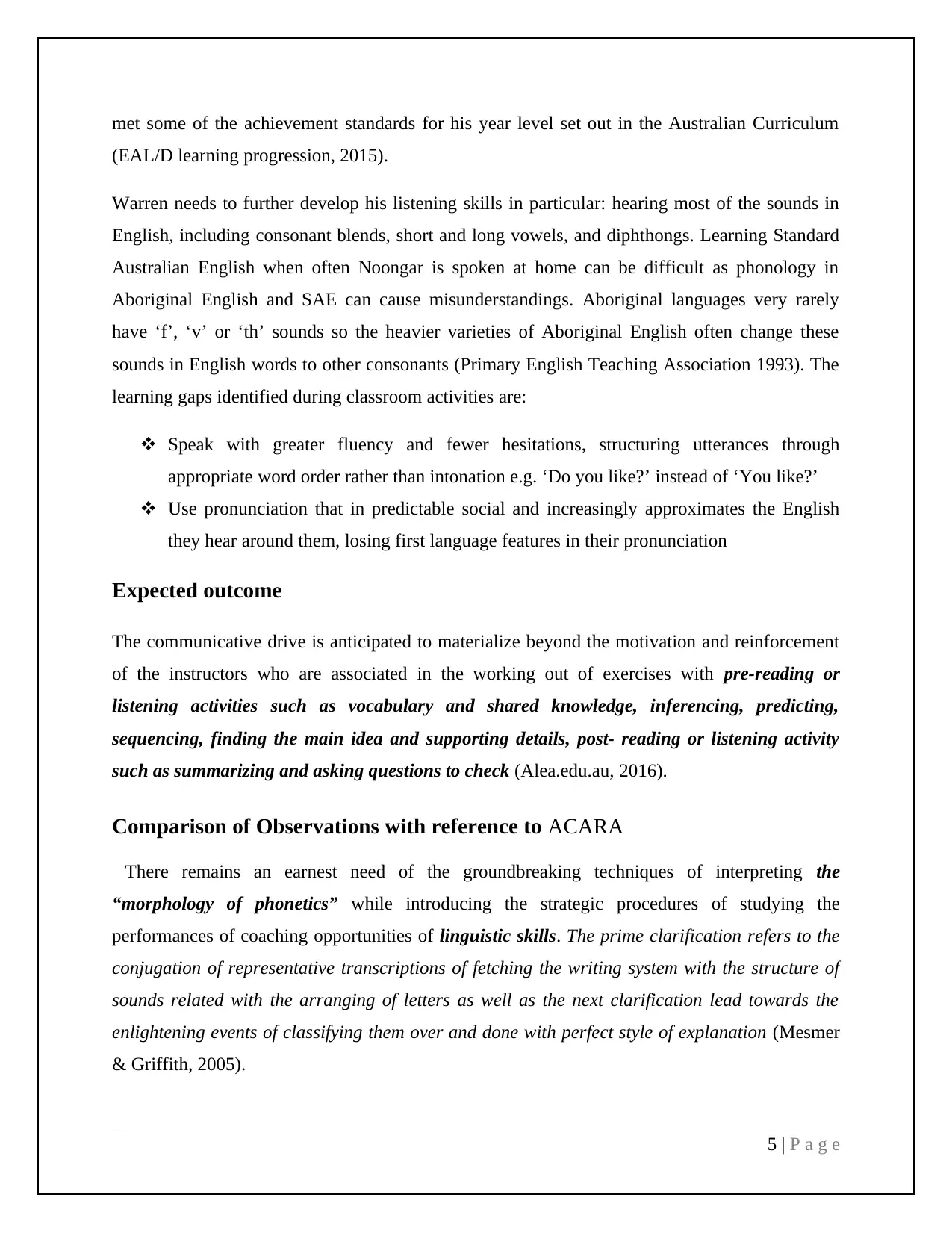
met some of the achievement standards for his year level set out in the Australian Curriculum
(EAL/D learning progression, 2015).
Warren needs to further develop his listening skills in particular: hearing most of the sounds in
English, including consonant blends, short and long vowels, and diphthongs. Learning Standard
Australian English when often Noongar is spoken at home can be difficult as phonology in
Aboriginal English and SAE can cause misunderstandings. Aboriginal languages very rarely
have ‘f’, ‘v’ or ‘th’ sounds so the heavier varieties of Aboriginal English often change these
sounds in English words to other consonants (Primary English Teaching Association 1993). The
learning gaps identified during classroom activities are:
Speak with greater fluency and fewer hesitations, structuring utterances through
appropriate word order rather than intonation e.g. ‘Do you like?’ instead of ‘You like?’
Use pronunciation that in predictable social and increasingly approximates the English
they hear around them, losing first language features in their pronunciation
Expected outcome
The communicative drive is anticipated to materialize beyond the motivation and reinforcement
of the instructors who are associated in the working out of exercises with pre-reading or
listening activities such as vocabulary and shared knowledge, inferencing, predicting,
sequencing, finding the main idea and supporting details, post- reading or listening activity
such as summarizing and asking questions to check (Alea.edu.au, 2016).
Comparison of Observations with reference to ACARA
There remains an earnest need of the groundbreaking techniques of interpreting the
“morphology of phonetics” while introducing the strategic procedures of studying the
performances of coaching opportunities of linguistic skills. The prime clarification refers to the
conjugation of representative transcriptions of fetching the writing system with the structure of
sounds related with the arranging of letters as well as the next clarification lead towards the
enlightening events of classifying them over and done with perfect style of explanation (Mesmer
& Griffith, 2005).
5 | P a g e
(EAL/D learning progression, 2015).
Warren needs to further develop his listening skills in particular: hearing most of the sounds in
English, including consonant blends, short and long vowels, and diphthongs. Learning Standard
Australian English when often Noongar is spoken at home can be difficult as phonology in
Aboriginal English and SAE can cause misunderstandings. Aboriginal languages very rarely
have ‘f’, ‘v’ or ‘th’ sounds so the heavier varieties of Aboriginal English often change these
sounds in English words to other consonants (Primary English Teaching Association 1993). The
learning gaps identified during classroom activities are:
Speak with greater fluency and fewer hesitations, structuring utterances through
appropriate word order rather than intonation e.g. ‘Do you like?’ instead of ‘You like?’
Use pronunciation that in predictable social and increasingly approximates the English
they hear around them, losing first language features in their pronunciation
Expected outcome
The communicative drive is anticipated to materialize beyond the motivation and reinforcement
of the instructors who are associated in the working out of exercises with pre-reading or
listening activities such as vocabulary and shared knowledge, inferencing, predicting,
sequencing, finding the main idea and supporting details, post- reading or listening activity
such as summarizing and asking questions to check (Alea.edu.au, 2016).
Comparison of Observations with reference to ACARA
There remains an earnest need of the groundbreaking techniques of interpreting the
“morphology of phonetics” while introducing the strategic procedures of studying the
performances of coaching opportunities of linguistic skills. The prime clarification refers to the
conjugation of representative transcriptions of fetching the writing system with the structure of
sounds related with the arranging of letters as well as the next clarification lead towards the
enlightening events of classifying them over and done with perfect style of explanation (Mesmer
& Griffith, 2005).
5 | P a g e
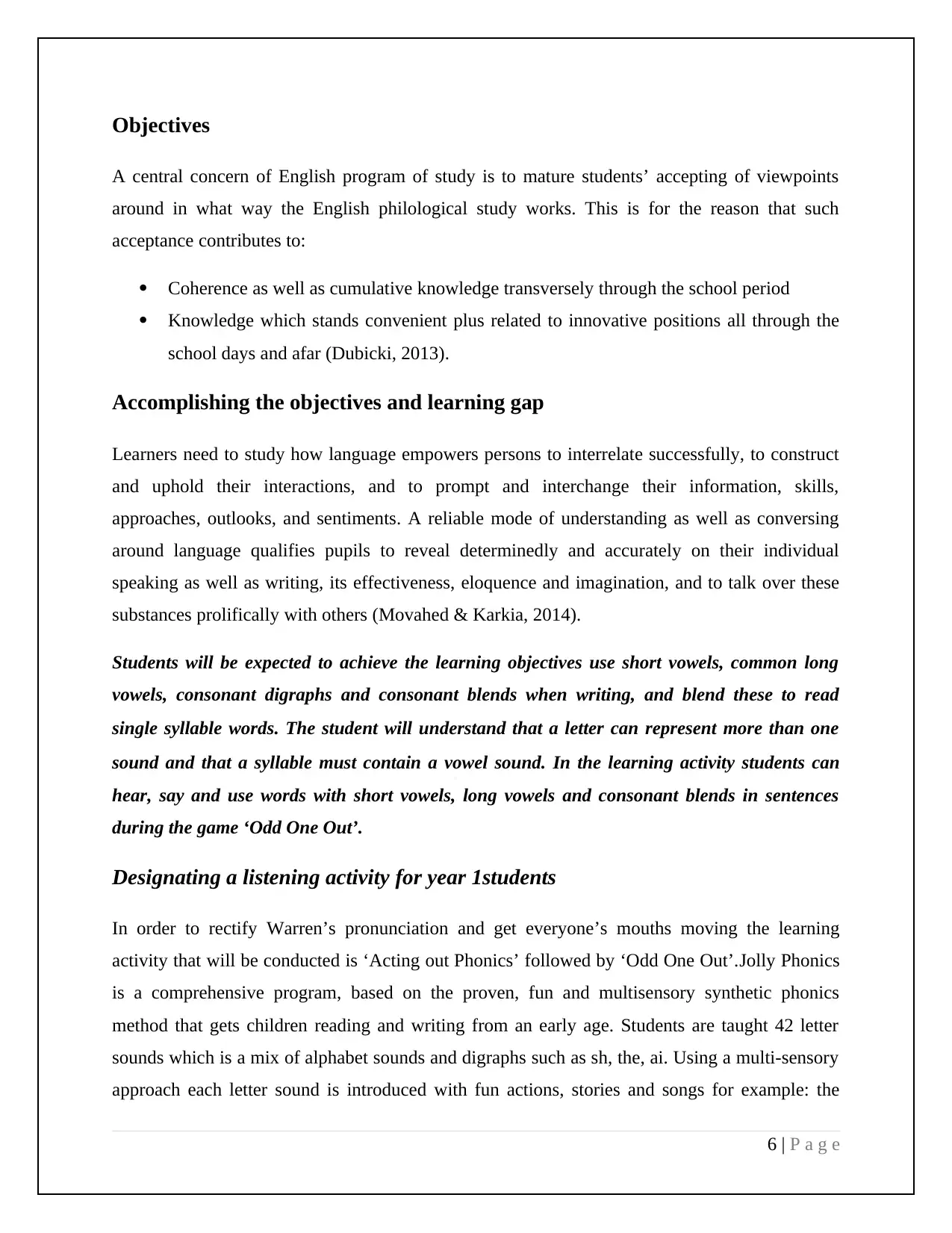
Objectives
A central concern of English program of study is to mature students’ accepting of viewpoints
around in what way the English philological study works. This is for the reason that such
acceptance contributes to:
Coherence as well as cumulative knowledge transversely through the school period
Knowledge which stands convenient plus related to innovative positions all through the
school days and afar (Dubicki, 2013).
Accomplishing the objectives and learning gap
Learners need to study how language empowers persons to interrelate successfully, to construct
and uphold their interactions, and to prompt and interchange their information, skills,
approaches, outlooks, and sentiments. A reliable mode of understanding as well as conversing
around language qualifies pupils to reveal determinedly and accurately on their individual
speaking as well as writing, its effectiveness, eloquence and imagination, and to talk over these
substances prolifically with others (Movahed & Karkia, 2014).
Students will be expected to achieve the learning objectives use short vowels, common long
vowels, consonant digraphs and consonant blends when writing, and blend these to read
single syllable words. The student will understand that a letter can represent more than one
sound and that a syllable must contain a vowel sound. In the learning activity students can
hear, say and use words with short vowels, long vowels and consonant blends in sentences
during the game ‘Odd One Out’.
Designating a listening activity for year 1students
In order to rectify Warren’s pronunciation and get everyone’s mouths moving the learning
activity that will be conducted is ‘Acting out Phonics’ followed by ‘Odd One Out’.Jolly Phonics
is a comprehensive program, based on the proven, fun and multisensory synthetic phonics
method that gets children reading and writing from an early age. Students are taught 42 letter
sounds which is a mix of alphabet sounds and digraphs such as sh, the, ai. Using a multi-sensory
approach each letter sound is introduced with fun actions, stories and songs for example: the
6 | P a g e
A central concern of English program of study is to mature students’ accepting of viewpoints
around in what way the English philological study works. This is for the reason that such
acceptance contributes to:
Coherence as well as cumulative knowledge transversely through the school period
Knowledge which stands convenient plus related to innovative positions all through the
school days and afar (Dubicki, 2013).
Accomplishing the objectives and learning gap
Learners need to study how language empowers persons to interrelate successfully, to construct
and uphold their interactions, and to prompt and interchange their information, skills,
approaches, outlooks, and sentiments. A reliable mode of understanding as well as conversing
around language qualifies pupils to reveal determinedly and accurately on their individual
speaking as well as writing, its effectiveness, eloquence and imagination, and to talk over these
substances prolifically with others (Movahed & Karkia, 2014).
Students will be expected to achieve the learning objectives use short vowels, common long
vowels, consonant digraphs and consonant blends when writing, and blend these to read
single syllable words. The student will understand that a letter can represent more than one
sound and that a syllable must contain a vowel sound. In the learning activity students can
hear, say and use words with short vowels, long vowels and consonant blends in sentences
during the game ‘Odd One Out’.
Designating a listening activity for year 1students
In order to rectify Warren’s pronunciation and get everyone’s mouths moving the learning
activity that will be conducted is ‘Acting out Phonics’ followed by ‘Odd One Out’.Jolly Phonics
is a comprehensive program, based on the proven, fun and multisensory synthetic phonics
method that gets children reading and writing from an early age. Students are taught 42 letter
sounds which is a mix of alphabet sounds and digraphs such as sh, the, ai. Using a multi-sensory
approach each letter sound is introduced with fun actions, stories and songs for example: the
6 | P a g e

letter ‘i’ we say ‘pretend to be a mouse and wiggle your fingers near your face like whiskers, ‘i,
i, i’. Each week a new group of 6 sounds are introduced to the students and practiced each day
before English lessons and activities. Jolly phonics helps students with letter formation, blending
the sounds together to help them read and write new words, segmenting by identifying the
phonic components that make the word sounds the way it does. Jolly phonics also enables
children to learn the exceptions to the rules of phonics when learning ‘tricky’ words. By
including the Jolly phonics activity before other learning activities, it activates the students mind
when it comes to forming words and hearing sounds.
‘Odd One Out’ will be a listening activity. I will put similar words in group of three – two with
one sound and one with a different sound (although similar) e.g. meat, seat, sit (vowels) and
plays, pace, space (consonants). I will have the students all standing at their desks behind their
chairs while I read the words out loud. Students will put their hands on their head if they think
the first word is odd, sit on the floor if they think it is the second word or fold their arms across
their chest if they think it is the third word. We will all then say the odd word out loud as a class
after everyone has made their decision. We will also say out loud the words that have the same
sounds, putting emphasis on the actual sounds. Each student will then have a go at making a
sentence out of the odd word, for example: The boy did not want to SIT on the mat. I will make
sure I include words that Warren has particular trouble with (words like ‘that’ as he says ‘dat’).
Ensuring he uses the words he struggles to say properly in a sentence to reiterate how it should
be said. This activity will help close the learning gap of not using phonics properly, speaking
with greater fluency and using correct pronunciation by meeting the learning objectives above
(Weideman, 2012).
The series of literary editions encompasses Australian collected works, counting the oral
description of backgrounds of “Aboriginal besides Torres Strait Islander” Pioneers, on top of
the modern-day texts of the cultural sets, and archetypal and current world literature,
comprising texts also from Asian regions. Literary writings that care and encompass students as
autonomous readers belong to a range of categories and include multifaceted, challenging and
changeable arrangements of design and mixed constructions that might serve manifold
commitments (www.education.nt.gov.au, 2019).
7 | P a g e
i, i’. Each week a new group of 6 sounds are introduced to the students and practiced each day
before English lessons and activities. Jolly phonics helps students with letter formation, blending
the sounds together to help them read and write new words, segmenting by identifying the
phonic components that make the word sounds the way it does. Jolly phonics also enables
children to learn the exceptions to the rules of phonics when learning ‘tricky’ words. By
including the Jolly phonics activity before other learning activities, it activates the students mind
when it comes to forming words and hearing sounds.
‘Odd One Out’ will be a listening activity. I will put similar words in group of three – two with
one sound and one with a different sound (although similar) e.g. meat, seat, sit (vowels) and
plays, pace, space (consonants). I will have the students all standing at their desks behind their
chairs while I read the words out loud. Students will put their hands on their head if they think
the first word is odd, sit on the floor if they think it is the second word or fold their arms across
their chest if they think it is the third word. We will all then say the odd word out loud as a class
after everyone has made their decision. We will also say out loud the words that have the same
sounds, putting emphasis on the actual sounds. Each student will then have a go at making a
sentence out of the odd word, for example: The boy did not want to SIT on the mat. I will make
sure I include words that Warren has particular trouble with (words like ‘that’ as he says ‘dat’).
Ensuring he uses the words he struggles to say properly in a sentence to reiterate how it should
be said. This activity will help close the learning gap of not using phonics properly, speaking
with greater fluency and using correct pronunciation by meeting the learning objectives above
(Weideman, 2012).
The series of literary editions encompasses Australian collected works, counting the oral
description of backgrounds of “Aboriginal besides Torres Strait Islander” Pioneers, on top of
the modern-day texts of the cultural sets, and archetypal and current world literature,
comprising texts also from Asian regions. Literary writings that care and encompass students as
autonomous readers belong to a range of categories and include multifaceted, challenging and
changeable arrangements of design and mixed constructions that might serve manifold
commitments (www.education.nt.gov.au, 2019).
7 | P a g e
Paraphrase This Document
Need a fresh take? Get an instant paraphrase of this document with our AI Paraphraser
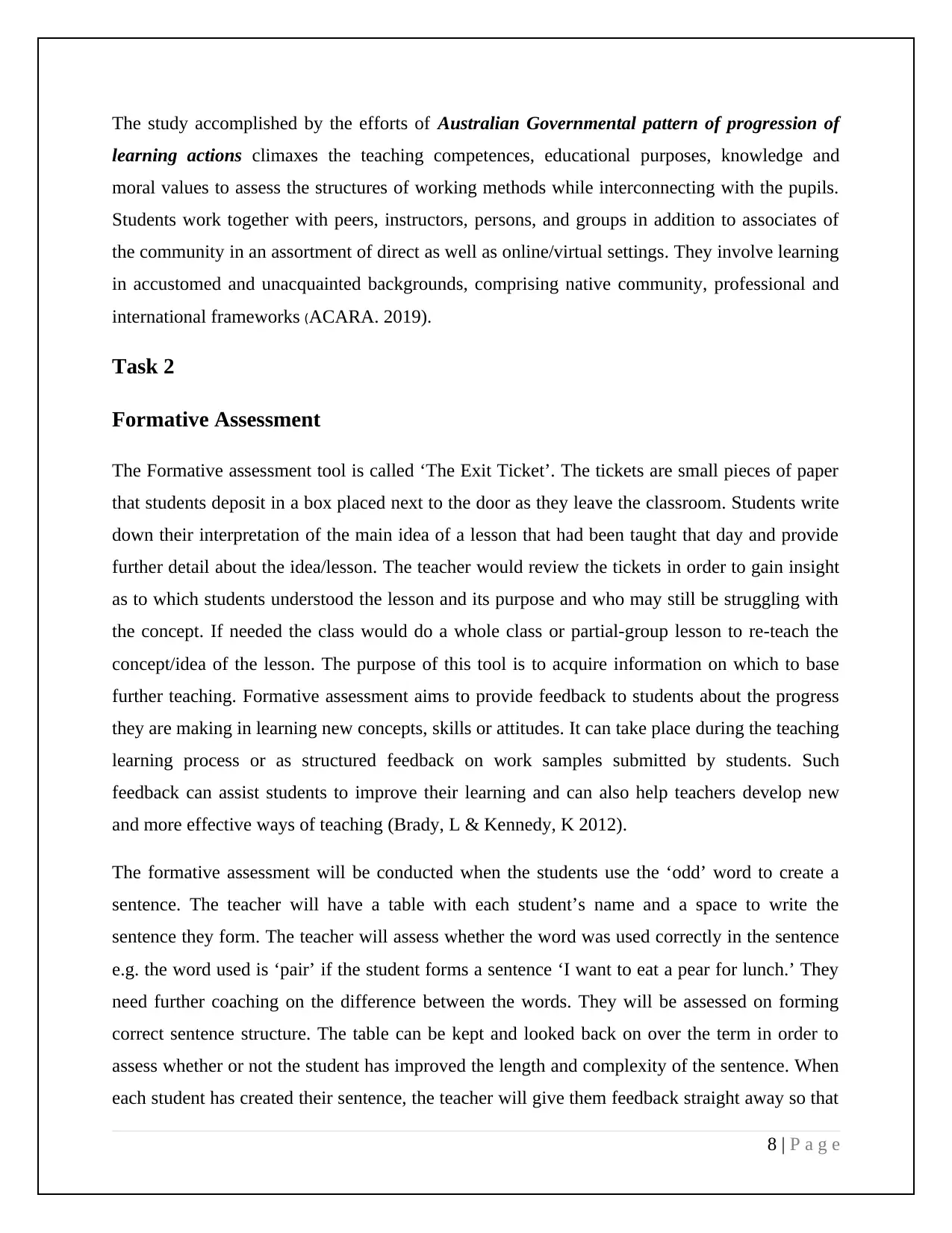
The study accomplished by the efforts of Australian Governmental pattern of progression of
learning actions climaxes the teaching competences, educational purposes, knowledge and
moral values to assess the structures of working methods while interconnecting with the pupils.
Students work together with peers, instructors, persons, and groups in addition to associates of
the community in an assortment of direct as well as online/virtual settings. They involve learning
in accustomed and unacquainted backgrounds, comprising native community, professional and
international frameworks (ACARA. 2019).
Task 2
Formative Assessment
The Formative assessment tool is called ‘The Exit Ticket’. The tickets are small pieces of paper
that students deposit in a box placed next to the door as they leave the classroom. Students write
down their interpretation of the main idea of a lesson that had been taught that day and provide
further detail about the idea/lesson. The teacher would review the tickets in order to gain insight
as to which students understood the lesson and its purpose and who may still be struggling with
the concept. If needed the class would do a whole class or partial-group lesson to re-teach the
concept/idea of the lesson. The purpose of this tool is to acquire information on which to base
further teaching. Formative assessment aims to provide feedback to students about the progress
they are making in learning new concepts, skills or attitudes. It can take place during the teaching
learning process or as structured feedback on work samples submitted by students. Such
feedback can assist students to improve their learning and can also help teachers develop new
and more effective ways of teaching (Brady, L & Kennedy, K 2012).
The formative assessment will be conducted when the students use the ‘odd’ word to create a
sentence. The teacher will have a table with each student’s name and a space to write the
sentence they form. The teacher will assess whether the word was used correctly in the sentence
e.g. the word used is ‘pair’ if the student forms a sentence ‘I want to eat a pear for lunch.’ They
need further coaching on the difference between the words. They will be assessed on forming
correct sentence structure. The table can be kept and looked back on over the term in order to
assess whether or not the student has improved the length and complexity of the sentence. When
each student has created their sentence, the teacher will give them feedback straight away so that
8 | P a g e
learning actions climaxes the teaching competences, educational purposes, knowledge and
moral values to assess the structures of working methods while interconnecting with the pupils.
Students work together with peers, instructors, persons, and groups in addition to associates of
the community in an assortment of direct as well as online/virtual settings. They involve learning
in accustomed and unacquainted backgrounds, comprising native community, professional and
international frameworks (ACARA. 2019).
Task 2
Formative Assessment
The Formative assessment tool is called ‘The Exit Ticket’. The tickets are small pieces of paper
that students deposit in a box placed next to the door as they leave the classroom. Students write
down their interpretation of the main idea of a lesson that had been taught that day and provide
further detail about the idea/lesson. The teacher would review the tickets in order to gain insight
as to which students understood the lesson and its purpose and who may still be struggling with
the concept. If needed the class would do a whole class or partial-group lesson to re-teach the
concept/idea of the lesson. The purpose of this tool is to acquire information on which to base
further teaching. Formative assessment aims to provide feedback to students about the progress
they are making in learning new concepts, skills or attitudes. It can take place during the teaching
learning process or as structured feedback on work samples submitted by students. Such
feedback can assist students to improve their learning and can also help teachers develop new
and more effective ways of teaching (Brady, L & Kennedy, K 2012).
The formative assessment will be conducted when the students use the ‘odd’ word to create a
sentence. The teacher will have a table with each student’s name and a space to write the
sentence they form. The teacher will assess whether the word was used correctly in the sentence
e.g. the word used is ‘pair’ if the student forms a sentence ‘I want to eat a pear for lunch.’ They
need further coaching on the difference between the words. They will be assessed on forming
correct sentence structure. The table can be kept and looked back on over the term in order to
assess whether or not the student has improved the length and complexity of the sentence. When
each student has created their sentence, the teacher will give them feedback straight away so that
8 | P a g e
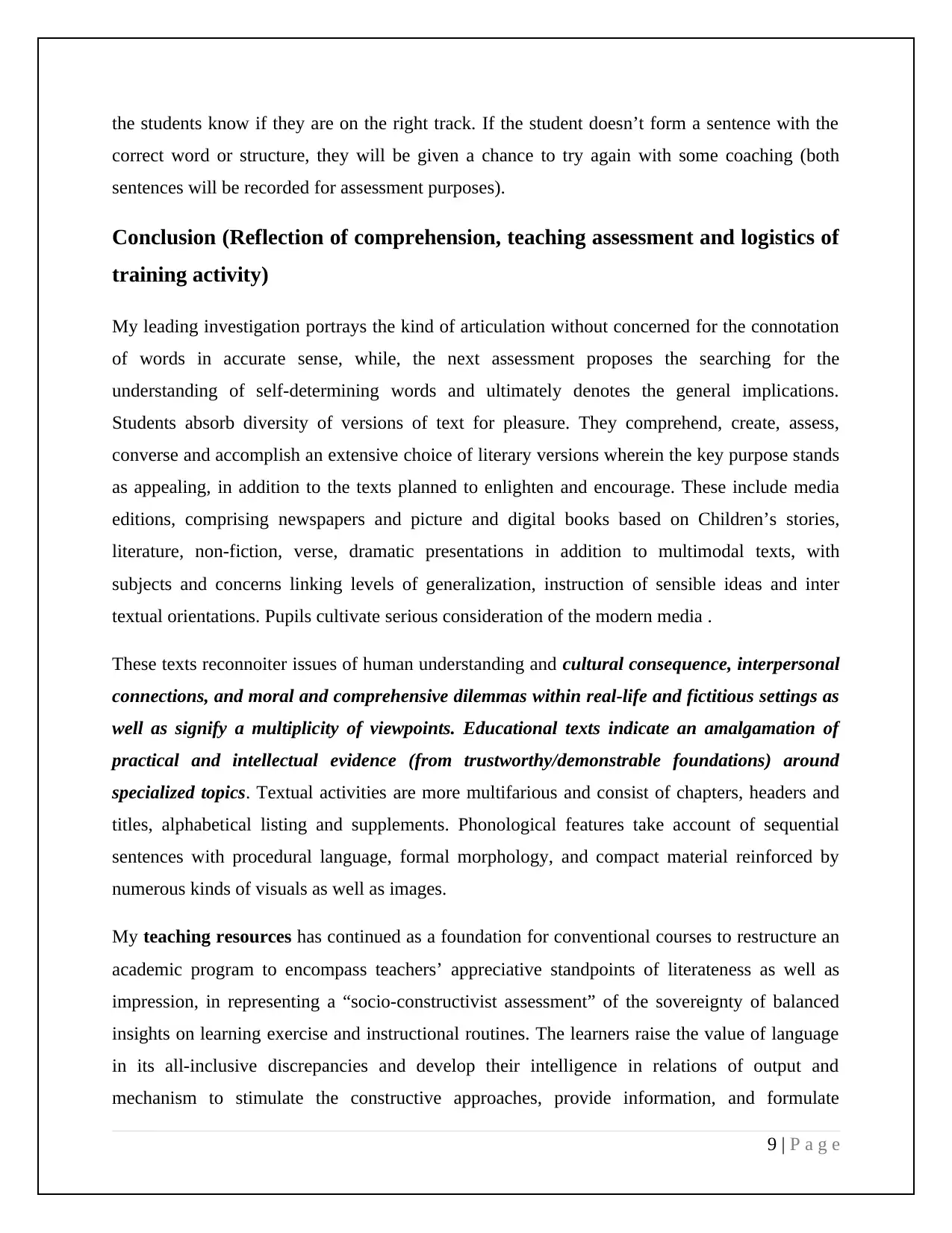
the students know if they are on the right track. If the student doesn’t form a sentence with the
correct word or structure, they will be given a chance to try again with some coaching (both
sentences will be recorded for assessment purposes).
Conclusion (Reflection of comprehension, teaching assessment and logistics of
training activity)
My leading investigation portrays the kind of articulation without concerned for the connotation
of words in accurate sense, while, the next assessment proposes the searching for the
understanding of self-determining words and ultimately denotes the general implications.
Students absorb diversity of versions of text for pleasure. They comprehend, create, assess,
converse and accomplish an extensive choice of literary versions wherein the key purpose stands
as appealing, in addition to the texts planned to enlighten and encourage. These include media
editions, comprising newspapers and picture and digital books based on Children’s stories,
literature, non-fiction, verse, dramatic presentations in addition to multimodal texts, with
subjects and concerns linking levels of generalization, instruction of sensible ideas and inter
textual orientations. Pupils cultivate serious consideration of the modern media .
These texts reconnoiter issues of human understanding and cultural consequence, interpersonal
connections, and moral and comprehensive dilemmas within real-life and fictitious settings as
well as signify a multiplicity of viewpoints. Educational texts indicate an amalgamation of
practical and intellectual evidence (from trustworthy/demonstrable foundations) around
specialized topics. Textual activities are more multifarious and consist of chapters, headers and
titles, alphabetical listing and supplements. Phonological features take account of sequential
sentences with procedural language, formal morphology, and compact material reinforced by
numerous kinds of visuals as well as images.
My teaching resources has continued as a foundation for conventional courses to restructure an
academic program to encompass teachers’ appreciative standpoints of literateness as well as
impression, in representing a “socio-constructivist assessment” of the sovereignty of balanced
insights on learning exercise and instructional routines. The learners raise the value of language
in its all-inclusive discrepancies and develop their intelligence in relations of output and
mechanism to stimulate the constructive approaches, provide information, and formulate
9 | P a g e
correct word or structure, they will be given a chance to try again with some coaching (both
sentences will be recorded for assessment purposes).
Conclusion (Reflection of comprehension, teaching assessment and logistics of
training activity)
My leading investigation portrays the kind of articulation without concerned for the connotation
of words in accurate sense, while, the next assessment proposes the searching for the
understanding of self-determining words and ultimately denotes the general implications.
Students absorb diversity of versions of text for pleasure. They comprehend, create, assess,
converse and accomplish an extensive choice of literary versions wherein the key purpose stands
as appealing, in addition to the texts planned to enlighten and encourage. These include media
editions, comprising newspapers and picture and digital books based on Children’s stories,
literature, non-fiction, verse, dramatic presentations in addition to multimodal texts, with
subjects and concerns linking levels of generalization, instruction of sensible ideas and inter
textual orientations. Pupils cultivate serious consideration of the modern media .
These texts reconnoiter issues of human understanding and cultural consequence, interpersonal
connections, and moral and comprehensive dilemmas within real-life and fictitious settings as
well as signify a multiplicity of viewpoints. Educational texts indicate an amalgamation of
practical and intellectual evidence (from trustworthy/demonstrable foundations) around
specialized topics. Textual activities are more multifarious and consist of chapters, headers and
titles, alphabetical listing and supplements. Phonological features take account of sequential
sentences with procedural language, formal morphology, and compact material reinforced by
numerous kinds of visuals as well as images.
My teaching resources has continued as a foundation for conventional courses to restructure an
academic program to encompass teachers’ appreciative standpoints of literateness as well as
impression, in representing a “socio-constructivist assessment” of the sovereignty of balanced
insights on learning exercise and instructional routines. The learners raise the value of language
in its all-inclusive discrepancies and develop their intelligence in relations of output and
mechanism to stimulate the constructive approaches, provide information, and formulate
9 | P a g e

concepts, over and above support to collaborate with others, display interest, influence and
discuss in discovering the methodology of “code breaking” (Merisuo-Storm & Soininen, 2014).
They comprehend how “Projected Australian English” roles in its spoken as well as written
actions and in incorporation of “non-linguistic procedures” of interaction on the way to create
meaning of assured terms ----denoting the methodologies of sense production
Improve attention and aptitudes while questioning the creative features of passages to the
instructor -- which they acquire new, as well as cultivate a knowledgeable gratitude of
composed literary section of approving articles as a measure of collected works
(www.education.nt.gov.au, 2019). This empowers to produce the principle of examining the
textual substance.
Students could be anticipated to request in the direction of abundant resources accessible to
improve as well as sustain the procedures indispensable to persist as an operative reader. These
features have engaged on practicality of their distinct characteristics throughout the sequence of
instructing the persons irrespective of the authors’ innovative determinations.
10 | P a g e
discuss in discovering the methodology of “code breaking” (Merisuo-Storm & Soininen, 2014).
They comprehend how “Projected Australian English” roles in its spoken as well as written
actions and in incorporation of “non-linguistic procedures” of interaction on the way to create
meaning of assured terms ----denoting the methodologies of sense production
Improve attention and aptitudes while questioning the creative features of passages to the
instructor -- which they acquire new, as well as cultivate a knowledgeable gratitude of
composed literary section of approving articles as a measure of collected works
(www.education.nt.gov.au, 2019). This empowers to produce the principle of examining the
textual substance.
Students could be anticipated to request in the direction of abundant resources accessible to
improve as well as sustain the procedures indispensable to persist as an operative reader. These
features have engaged on practicality of their distinct characteristics throughout the sequence of
instructing the persons irrespective of the authors’ innovative determinations.
10 | P a g e
Secure Best Marks with AI Grader
Need help grading? Try our AI Grader for instant feedback on your assignments.
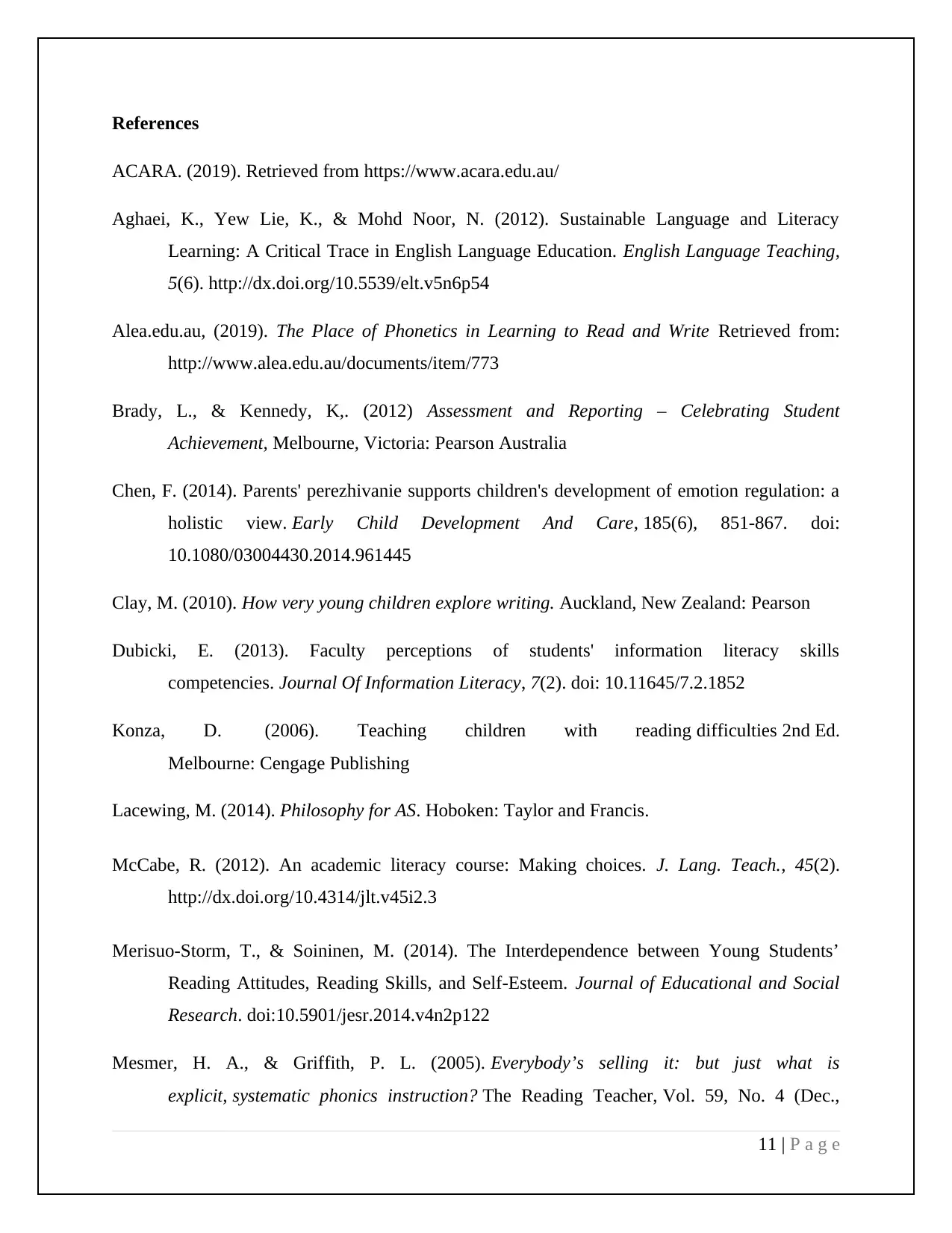
References
ACARA. (2019). Retrieved from https://www.acara.edu.au/
Aghaei, K., Yew Lie, K., & Mohd Noor, N. (2012). Sustainable Language and Literacy
Learning: A Critical Trace in English Language Education. English Language Teaching,
5(6). http://dx.doi.org/10.5539/elt.v5n6p54
Alea.edu.au, (2019). The Place of Phonetics in Learning to Read and Write Retrieved from:
http://www.alea.edu.au/documents/item/773
Brady, L., & Kennedy, K,. (2012) Assessment and Reporting – Celebrating Student
Achievement, Melbourne, Victoria: Pearson Australia
Chen, F. (2014). Parents' perezhivanie supports children's development of emotion regulation: a
holistic view. Early Child Development And Care, 185(6), 851-867. doi:
10.1080/03004430.2014.961445
Clay, M. (2010). How very young children explore writing. Auckland, New Zealand: Pearson
Dubicki, E. (2013). Faculty perceptions of students' information literacy skills
competencies. Journal Of Information Literacy, 7(2). doi: 10.11645/7.2.1852
Konza, D. (2006). Teaching children with reading difficulties 2nd Ed.
Melbourne: Cengage Publishing
Lacewing, M. (2014). Philosophy for AS. Hoboken: Taylor and Francis.
McCabe, R. (2012). An academic literacy course: Making choices. J. Lang. Teach., 45(2).
http://dx.doi.org/10.4314/jlt.v45i2.3
Merisuo-Storm, T., & Soininen, M. (2014). The Interdependence between Young Students’
Reading Attitudes, Reading Skills, and Self-Esteem. Journal of Educational and Social
Research. doi:10.5901/jesr.2014.v4n2p122
Mesmer, H. A., & Griffith, P. L. (2005). Everybody’s selling it: but just what is
explicit, systematic phonics instruction? The Reading Teacher, Vol. 59, No. 4 (Dec.,
11 | P a g e
ACARA. (2019). Retrieved from https://www.acara.edu.au/
Aghaei, K., Yew Lie, K., & Mohd Noor, N. (2012). Sustainable Language and Literacy
Learning: A Critical Trace in English Language Education. English Language Teaching,
5(6). http://dx.doi.org/10.5539/elt.v5n6p54
Alea.edu.au, (2019). The Place of Phonetics in Learning to Read and Write Retrieved from:
http://www.alea.edu.au/documents/item/773
Brady, L., & Kennedy, K,. (2012) Assessment and Reporting – Celebrating Student
Achievement, Melbourne, Victoria: Pearson Australia
Chen, F. (2014). Parents' perezhivanie supports children's development of emotion regulation: a
holistic view. Early Child Development And Care, 185(6), 851-867. doi:
10.1080/03004430.2014.961445
Clay, M. (2010). How very young children explore writing. Auckland, New Zealand: Pearson
Dubicki, E. (2013). Faculty perceptions of students' information literacy skills
competencies. Journal Of Information Literacy, 7(2). doi: 10.11645/7.2.1852
Konza, D. (2006). Teaching children with reading difficulties 2nd Ed.
Melbourne: Cengage Publishing
Lacewing, M. (2014). Philosophy for AS. Hoboken: Taylor and Francis.
McCabe, R. (2012). An academic literacy course: Making choices. J. Lang. Teach., 45(2).
http://dx.doi.org/10.4314/jlt.v45i2.3
Merisuo-Storm, T., & Soininen, M. (2014). The Interdependence between Young Students’
Reading Attitudes, Reading Skills, and Self-Esteem. Journal of Educational and Social
Research. doi:10.5901/jesr.2014.v4n2p122
Mesmer, H. A., & Griffith, P. L. (2005). Everybody’s selling it: but just what is
explicit, systematic phonics instruction? The Reading Teacher, Vol. 59, No. 4 (Dec.,
11 | P a g e
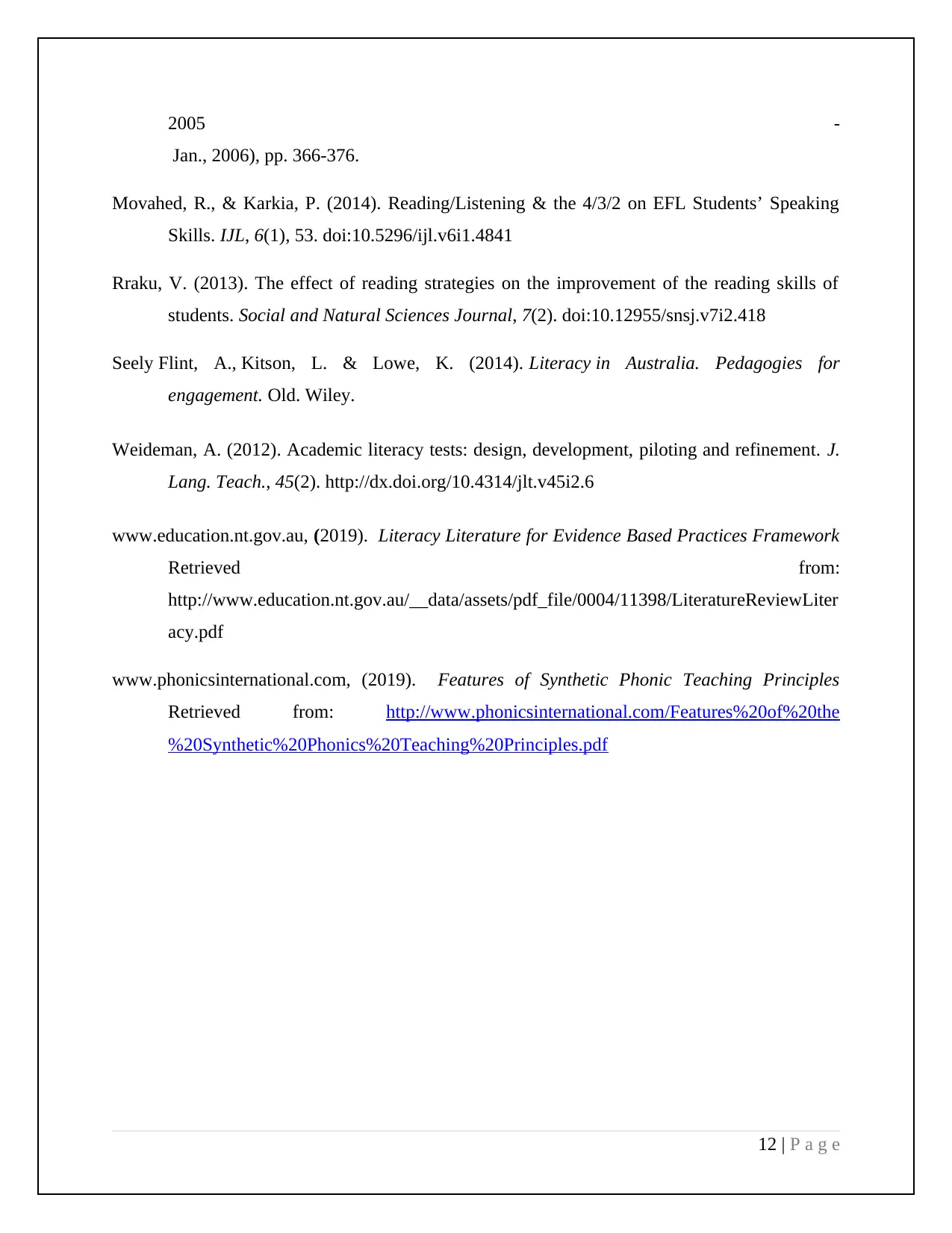
2005 -
Jan., 2006), pp. 366-376.
Movahed, R., & Karkia, P. (2014). Reading/Listening & the 4/3/2 on EFL Students’ Speaking
Skills. IJL, 6(1), 53. doi:10.5296/ijl.v6i1.4841
Rraku, V. (2013). The effect of reading strategies on the improvement of the reading skills of
students. Social and Natural Sciences Journal, 7(2). doi:10.12955/snsj.v7i2.418
Seely Flint, A., Kitson, L. & Lowe, K. (2014). Literacy in Australia. Pedagogies for
engagement. Old. Wiley.
Weideman, A. (2012). Academic literacy tests: design, development, piloting and refinement. J.
Lang. Teach., 45(2). http://dx.doi.org/10.4314/jlt.v45i2.6
www.education.nt.gov.au, (2019). Literacy Literature for Evidence Based Practices Framework
Retrieved from:
http://www.education.nt.gov.au/__data/assets/pdf_file/0004/11398/LiteratureReviewLiter
acy.pdf
www.phonicsinternational.com, (2019). Features of Synthetic Phonic Teaching Principles
Retrieved from: http://www.phonicsinternational.com/Features%20of%20the
%20Synthetic%20Phonics%20Teaching%20Principles.pdf
12 | P a g e
Jan., 2006), pp. 366-376.
Movahed, R., & Karkia, P. (2014). Reading/Listening & the 4/3/2 on EFL Students’ Speaking
Skills. IJL, 6(1), 53. doi:10.5296/ijl.v6i1.4841
Rraku, V. (2013). The effect of reading strategies on the improvement of the reading skills of
students. Social and Natural Sciences Journal, 7(2). doi:10.12955/snsj.v7i2.418
Seely Flint, A., Kitson, L. & Lowe, K. (2014). Literacy in Australia. Pedagogies for
engagement. Old. Wiley.
Weideman, A. (2012). Academic literacy tests: design, development, piloting and refinement. J.
Lang. Teach., 45(2). http://dx.doi.org/10.4314/jlt.v45i2.6
www.education.nt.gov.au, (2019). Literacy Literature for Evidence Based Practices Framework
Retrieved from:
http://www.education.nt.gov.au/__data/assets/pdf_file/0004/11398/LiteratureReviewLiter
acy.pdf
www.phonicsinternational.com, (2019). Features of Synthetic Phonic Teaching Principles
Retrieved from: http://www.phonicsinternational.com/Features%20of%20the
%20Synthetic%20Phonics%20Teaching%20Principles.pdf
12 | P a g e
1 out of 12
Your All-in-One AI-Powered Toolkit for Academic Success.
+13062052269
info@desklib.com
Available 24*7 on WhatsApp / Email
![[object Object]](/_next/static/media/star-bottom.7253800d.svg)
Unlock your academic potential
© 2024 | Zucol Services PVT LTD | All rights reserved.




